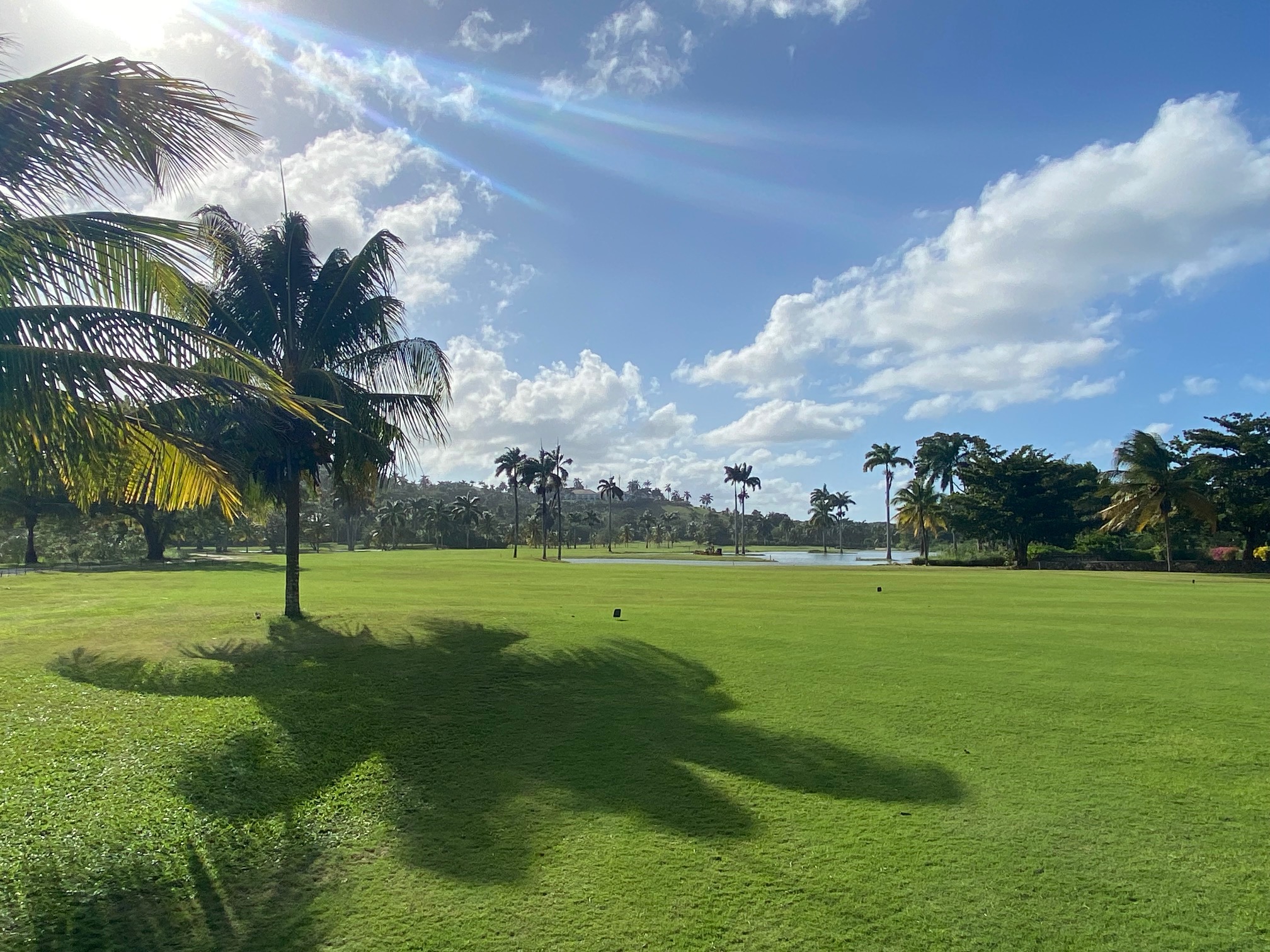The Pebble Beach Pilgrimage: Where to Play
Aug 11th 2020

Your “girlfriends guide” to where to play, where to stay, and what to wear
Whether you’ve been planning your next golf trip or simply daydreaming about it, there’s a pretty good chance your mind has wandered at least once to the idyllic setting of Pebble Beach. With fairways touting sweeping views of Carmel beach, and the most dramatic 18th hole anywhere, you’d think you’d died and gone to heaven — but alas, you’d still have 3 more 18-hole courses to play!
World-class golf in the world’s best climate, do we dare ask for anything more? Indeed. They certainly weren’t going to stop there; the accommodations (of which your choices are widely varied and singularly remarkable) will be what you daydream about while you’re meandering from green to tee box.
Fancy a massage to loosen up before dinner? THIS is the place to splurge. The spa at Pebble Beach is one of only 60 in the world that have earned a Forbes Five Star Award!
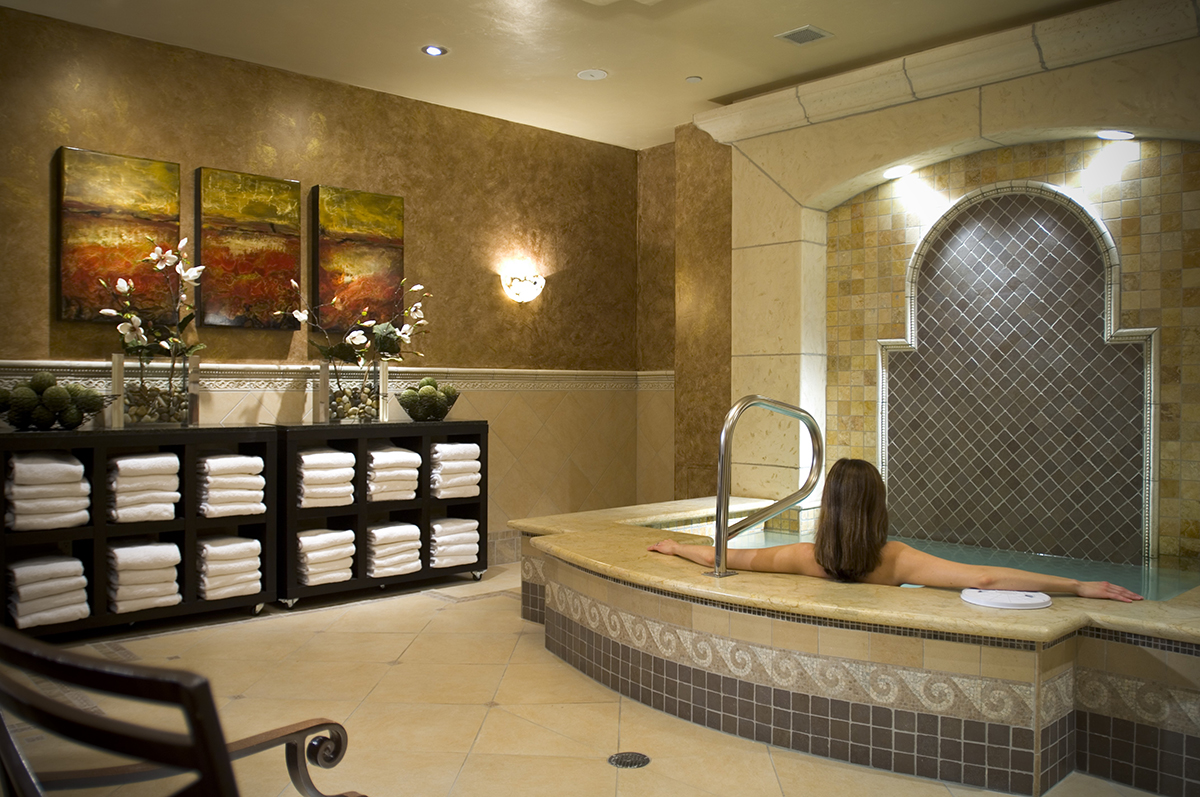
(Photo credit Scott Campbell)
By now you’ve probably guessed, we’ve barely scratched the surface of the Pebble Beach Pilgrimage. “Travel” along with us as we help to feed your dreams…
First, a little Pebble Beach history lesson
One of the most historic, beautiful, iconic golf courses in the world, the Pebble Beach Golf Links in Pebble Beach, California lies along the coastline with majestic views of Carmel Bay along the south side of the Monterey Peninsula.
This course has the distinction of being the #1 rated public golf course in the United States by Golf Digest. The prestige of the course comes with a stiff greens fee, at over $500 per round excluding cart fee. One of four golf courses that belong to the Pebble Beach Company, Pebble Beach Golf Links is joined by Del Monte Golf Course, Spyglass Hill Golf Course, and The Links at Spanish Bay.
Professional events take place annually at Pebble Beach, including the AT&T Pebble Beach Pro-Am and First Tee Open. Among the top golf events that have been held at Pebble Beach include six US Opens, a PGA Championship, and the LPGA Tour’s 1988 Nabisco Championship.
The history of Pebble Beach Golf Links dates back to 1880 when Hotel del Monte opened. It began as part of the complex built by Charles Crocker. The course itself was designed by Jack Neville and Douglas Grant nearly 40 years later, opening on February 22, 1919. There have been revisions to the course over the years, starting in 1927 by Alistair McKenzie and Robert Hunter, H. Chandler Egan in 1928, and the new fifth hole in 1998 by Jack Nicklaus. After changing hands a few times, Pebble Beach has settled and flourished under the exceptional management of its current owners.
Tournament History
The Monterey Peninsula Open in 1926 was the first professional event at the venue. Harry Cooper won the 72-hole event with a score of +5, earning the $5,000 prize money. Three years later, the US Amateur match-play was won by Jimmy Johnston.
No professional event was held at Pebble Beach again until 1947 when the Bing Crosby National Pro-Am began its long run. The tournament, held in February, is played at Pebble Beach, Monterey Peninsula Country Club and Spyglass Hill for the first three rounds, returning to Pebble Beach on Sunday to determine the champion.
The first of six US Opens held at Pebble Beach was in 1972. The illustrious winners include Jack Nicklaus, Tom Watson, Tom Kite, Tiger Woods, Graeme McDowell, and Gary Woodland. In addition, the course also saw the 1977 PGA Championship playoff win by Lanny Wadkins against Gene Littler.
The Pebble Beach Pilgrimage: Course Layout — Pebble Beach Golf Links
(Photo Credit Sherman Chu)
The idea behind this course’s design was to put as many holes along the rugged coastline as possible. After two holes inland, the third goes toward the Pacific Ocean, while the next two move along the Stillwater Cove, as does the reworked fifth hole. The next three holes are located at Arrowhead Point, while eight through ten are located above Carmel Bay. The next six consecutive holes are away from the water, while the par-5 18th with the Pacific Ocean along the left is arguably the greatest finishing hole in golf.
In 2023, Pebble Beach will be the first course to host a men's, women's, and senior men's golf tournament in the same calendar year, as the course will host the US Women's Open.
Front Nine
1. The course begins with a 377-yard, par 4. An iron is a smart choice off the tee toward a bunker at the edge of the fairway, about 150 yards from the green. But careful with the approach since the green slopes toward the ocean from back-to-front.
2. At the 511-yard, par 5 2nd (par-4 at the US Open), the hole is reachable by the competent player in two. However, for those that wish to layup, be aware of a bunker across the fairway around 100 yards from the green.
3. The 3rd hole is a dogleg left par 4 of 390 yards. Bunkers line both sides of the fairway and the green runs out toward the ocean. For the daring, long-ball hitters, a shot over the trees will leave you with just a short wedge into the green.
4. The short 326-yard par 4 4th has plenty of trouble looming, despite the fact it played under par at last year’s US Open. The ocean clearly comes into play, as do the nine bunkers around the green and fairway.
5. At 192 yards, this medium distance par 3 5th has a bunker behind the green which moves from the front-left to the back-right. This whole was designed by Jack Nicklaus in 1998.
6. This 506-yard par 5 features an extremely elevated second shot toward the second part of the fairway that climbs more than 30 feet. Water comes into play on errant shots to the right. The smart choice for the average player is to layup.
7. The best advice for the barely over 100-yard par 3 7th is to check the wind direction from the sixth green. Depending on the direction and severity of the wind, this tiny hole may require anywhere from a lob wedge to long iron to reach.
8. The tee shot on this 427-yard, par 4 8th is a rather blind shot to the fairway when it goes over a cliff approximately 240 yards from the tee. The second shot over a seaside ravine to a severely sloped back-to-front green presents a challenge even to PGA Tour players.
9. The most difficult hole at the 2019 US Open, the 481-yard, par-4 9th has a fairway that rises for about 200 yards before trailing to the right toward the beach. The green is well-protected by bunkers. A par is a great score here.
Back Nine
10. The 10th hole features the most generous fairway on the course, sloping toward the beach. The second shot will be a sidehill lie to a green near the cliff some 450 yards away from the tee.
11. The best approach at the 373-yard, par 4 11th hole is to aim for the left side of the fairway. This sets up an approach to a very small green that slopes drastically to the back.
12. A moderately long par 3 at 201 yards, the 12th hole requires a precise tee shot to a green protected by bunkers. With the ocean in play on balls hit long, the best play is to land short or just on the shallow green.
13. The 403-yard, par 4 13th features a fairway bunker on the left which must be contended with for best angle to the green. Be aware that the green runs toward the ocean, so landing short is the best option.
14. At 572-yards, the par 5 14th is a true test to even the best players. In fact, it played over par in last year’s US Open. The green is elevated, so the closer you can get to the green for a short third, the better.
15. The 15th is a 396-yard, par 4 hole with a pot bunker that can come into play off the tee. An approach of about 120 yards is ideal toward a green slope toward the ocean.
16. The best approach for this 401-yard, par 4 16th is a shot over the island bunker to the middle of the fairway. From there the lie will be reasonably flat from nearly 150 yards to a right-to-left sloping green.
17. The 177-yard, par 3 17th varies in distance due to the long narrow green. Depending on the wind and pin-placement a short to long iron could be the play. The most famous shot here was by Jack Nicklaus hitting the flag with a 1-iron into the wind to the back left pin location.
18. At last, the most picturesque and likely most famous 18th in golf. This par-5 of 543 yards sees aggressive tee shots that flirt with the water on the left of a big tree in the fairway. A safe play will lead to a wedge third for a chance at birdie.
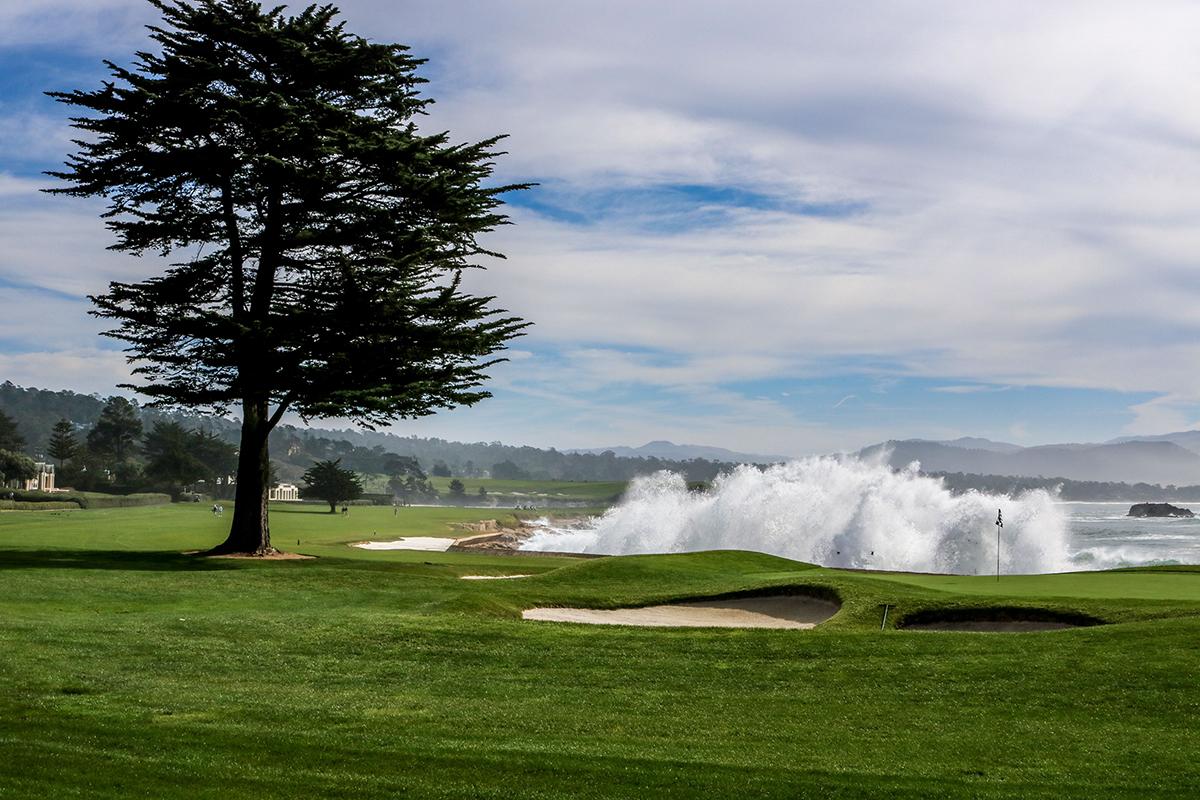
(Photo Credit Pebble Beach Company)
The Pebble Beach Pilgrimage: Course Layout — Spyglass Hill
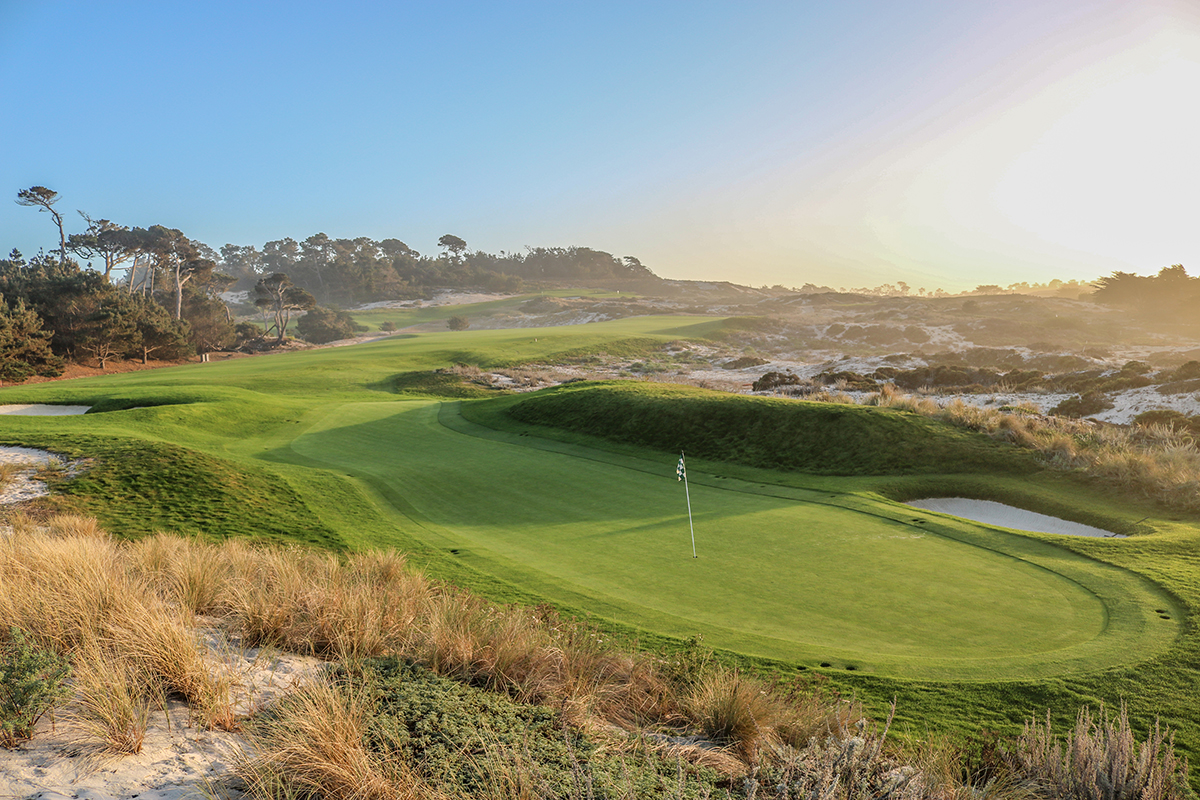
(Photo Credit Pebble Beach Company)
This par-72 ranges from 5381 yards to 6960 with beautiful views of the ocean with holes meandering through the dunes, allowing you to fully appreciate the picturesque Del Monte Forest. Those who have trekked around Spyglass Hill have found it to be the most remarkable meeting of sand and trees — and many of their golf balls would agree (as they also met the sand and trees). Spyglass Hill co-hosts the annual AT&T Pebble Beach Pro-Am and hosted the US Amateur in both 1999 and 2018.
Front Nine
1. Spyglass Hill starts with a 595-yard, downhill par 5 that moves sharply to the left to a vertically tiered elevated green. Take note to enjoy the view of Monterey Bay, the canopy of the Del Monte Forest and the Santa Cruz mountains from the teeing area.
2. Although a short par 4 at 349 yards, this 2nd hole requires a layup to the bottom of the hill about 220 yards from the tee. The narrow, elevated green combined with unpredictable wind and pin placement provides a challenging approach shot.
3. Another great view from the tee, this 172-yard par 3 features a downhill tee shot facing the Pacific Ocean. Nearly always breezy, club selection is difficult. To complicate matters further, the green features many putts that will move quickly toward the ocean.
4. The beautifully designed 4th by Robert Trent Jones Sr is not long at 370 yards. However, the long, meandering, narrow green measuring 55 yards long and ten yards wide is in between two bunkers. The knowledge of the hole location will determine a strategy on your approach.
5. The 197-yard, par 3 5th hole along the ocean features a tee shot to an uphill green with bunkers and dunes surrounding it. The best play is to aim for the middle of the green.
6. Moving from the ocean holes, Spyglass Hill takes a dramatic change through the Del Monte Forest beginning with the 446-yard, par 4 6th. The enormous green has three very different sections that play quite differently.
7. The par 5, 545-yard 7th hole is reachable in two with a long drive. Not feeling comfortable about going for it? Then layup about 100 yards directly behind the pond for a shot to the green that slants dramatically from back to front and left to right.
8. Don’t let the yardage fool you. This 399-yard 8th hole nearly always leaves players with a hanging lie to an elevated green. Players must take extra club than the yardage markers indicate on their approaches to the green.
9. The par 4, 431-yard 9th plays much longer due to an elevated green. In addition, deep bunkers guard the green. A par on the closing hole to the front nine is a great way to make the turn.
Back nine
10. Begin the back nine with this par 4 of 407 yards. This dogleg hold has a tree that must be avoided along the left side of the fairway with either a layup or substantial poke around the corner. The downhill second is tough to hold on a green running away from the front.
11. Only the longest and most aggressive players should look to get home in two at this par 5 of 562 yards. The best layup is within full wedge range and beware of the bunkers surrounding the right side of the green.
12. The 178-yard par 3 12th hole features a downhill tee shot over a pond. Be careful of club selection, so check the wind of this shot that faces the ocean that is hidden from view by the thick forest.
13. At 460 yards, this par 4 13th hole plays longer in a sneaky way. You won’t realize how much uphill this plays until you reach the green. Be aware of the elevated green that slopes drastically to the front.
14. A difficult 560-yard, par 5 double dogleg is very difficult to reach in two. For those daring enough to try to reach the green in two, they have to contend with a large pond in front of the green. A birdie is an excellent score, with par the norm.
15. The 15th is a short par 3 of 130 yards. Another downhill tee shot with a pond in front and a hill of bunkers long. Be aware of a tier in the green dividing the upper half from the lower half.
16. The 16th is a 476-yard par 4 dogleg to the right. Long hitters may need to shape their shot to avoid hitting out of bounds, so be conscious of the yardage. A large sloping green makes three putts a distinct possibility.
17. Another dogleg featured on the back nine, this one to the left on the 325-yard par 4. An iron off the tee will lead to a relatively short approach to a very steep green.
18. The home hole is a 433-yard, par 4 with a fairly simplistic tee shot with only a single fairway bunker in play. The green is two-tiered, making putts on this final hole among the toughest on the course.
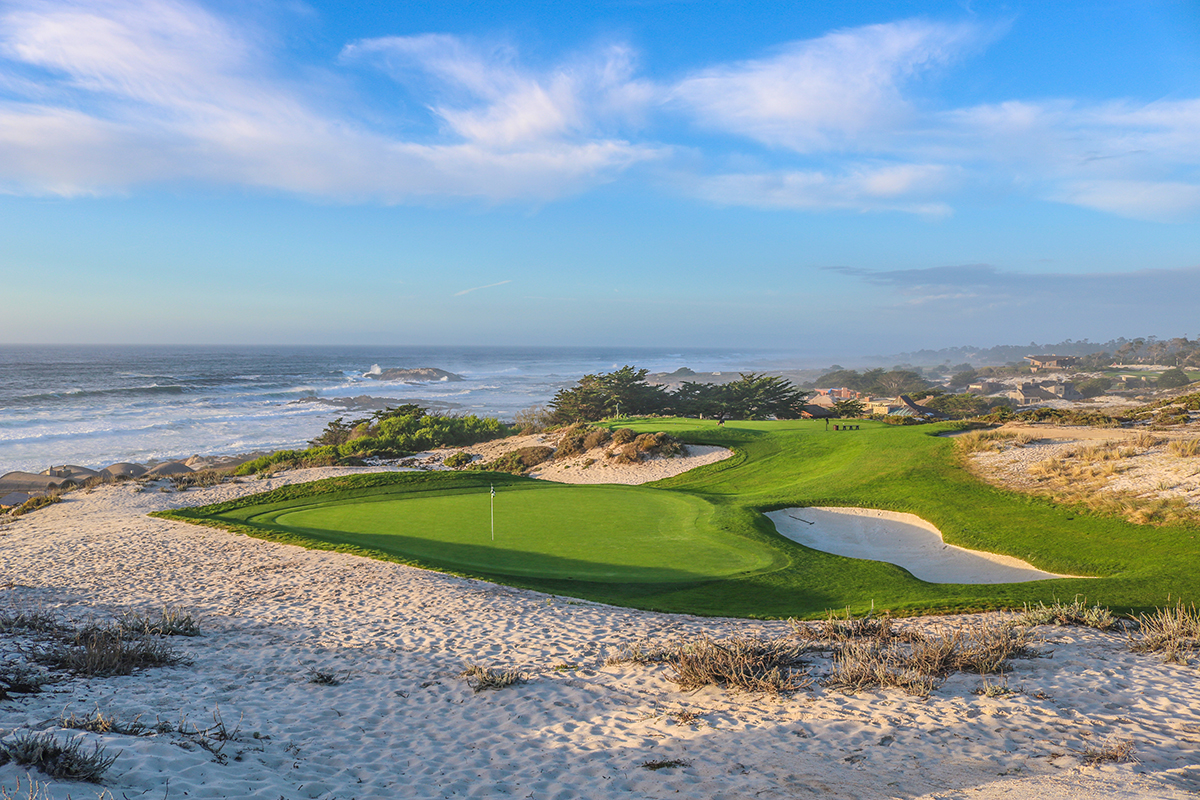
(Photo Credit Pebble Beach Company)
The Pebble Beach Pilgrimage: Course Layout — The Links at Spanish Bay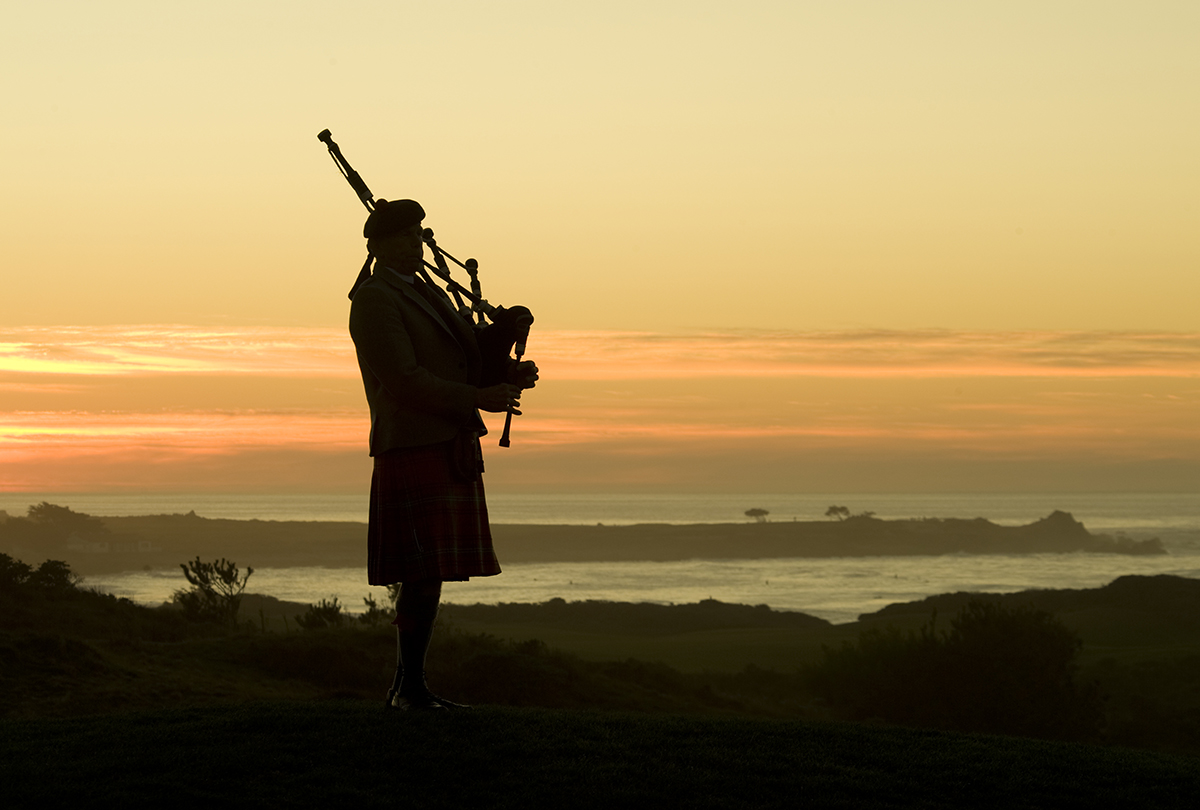
(Photo credit Joanne Dost)
If you enjoy sweeping sand dunes and breathtaking seaside views while playing once-in-a-lifetime (Who are we kidding? You’ll be back!) then The Links at Spanish Bay is for you. The gently hilly fairways move through dunes, are nestled between Monterey Pines, then return to the Spanish Bay Beach on this par-72 course that ranges from 5332 to 6821 yards. To top off this ultimate golf experience, play at twilight and enjoy the Spanish Bay bagpiper.
Spanish Bay hosts the TaylorMade Pebble Beach Invitational and is regularly rated as one of the top public courses, both California and nationwide.
Front nine
1. The opening hole is a par 5 measuring 500 yards. A well-positioned drive gives the player the option to go for the green or play a safe second to the left side of the fairway. There is a beautiful view of the Pacific Ocean past the green on this hole where birdie is a good possibility.
2. The choice on the short, 307-yard par 4 is to try to blast a drive to the green or long iron for a wedge approach shot. The green is complex, divided into four distinct regions.
3. The play from the tee on this 407-yard, par 4 hole is to aim at a bunker down the left side. If the wind is at your back, blast one over one of the several bunkers to set up a decent approach for a birdie possibility.
4. On this 4th hole measuring 190 yards, correct club selection and precision is the key to hit the correct part of the three-tiered green. Lack of precision can easily lead to a bogey on this hole.
5. The 5th hole is a 451-yard, par 4 with three pot bunkers that must be contended with off the tee. Play to a razor-thin landing area along the right for a decent approach or the wide left side for a long second shot? A par is a very good score on this hole.
6. Not an overly long par 4, the 6th hole measures 400 yards with eight bunkers lining the right side of the fairway. Avoid them to give yourself a short to medium iron into another multiple tiered green.
7. Another difficult tee shot presents itself at the 418-yard, par 4 7th as the fairway becomes increasingly narrow the farther you hit the ball. Players must be aware that the right side of the green is on a higher tier than the left.
8. Although measuring only 158 yards, this par 3 is surrounded by bunkers with difficult pin locations. Add in the wind from the ocean and a par is a great score here.
9. Don’t let the sub-400 yard measurement of this 9th hole fool you. The sand dune along the right is out of bounds and marsh is along the left. The fairway is difficult to hit and the green is very deep with a swale into the right side. You’ll be happy to walk away with a part to finish the front nine.
Back nine
10. The back nine begins with a 520-yard par 5. While this hole is reachable in two, the fairway narrows considerably with three pot bunkers to deal with. The green has plenty of slope that leads into a bottom tier. Getting a birdie on this hole is a real accomplishment.
11. On the 11th, the tee shot on this 365-yard hole can get relatively close to an elevated green. The best option could be to lay up with a long iron or fairway wood to allow for the best chance of holding the green.
12. The key to the 432-yard 12th hold is hitting the fairway off the tee. If not, carrying the ravine to the green is very unlikely. Be careful of the very rapid green that runs toward the ocean.
13. A very short par 3 of 126 yards requires an accurate shot over the ravine. Generally, the shot is played into the wind to a green that slopes from back-to-front, so take more club than normal.
14. At 576 yards, the par 5 14th is very difficult to reach in two if there is a breeze coming off the ocean. Accuracy is a must with marsh lining the right and out of bounds down the left.
15. The 15th is a 390-yard par 4 with two bunkers in play off the tee. The smart shot is to aim left and set up a short iron or wedge approach to a green with a swale on the left side.
16. The green on this 200-yard par 3 is divided by a large hump. A mid to long iron is required, depending on the wind with the prudent option to aim for the left side of the green.
17. A layup tee shot is the best option on the 413-yard par 4 17th. Not a difficult green to hit, but tough to putt since it’s two-tiered sloping left-to-right.
18. The home hole is a par 5 measuring 574 yards. A hazard is in the middle, prompting many players to lay up into the wide part of the fairway. Another two-tiered green makes a third shot easy to hold, giving players a look at birdie.

(Photo credit Pebble Beach Company)
The Pebble Beach Pilgrimage: Course Layout — Del Monte Golf Course
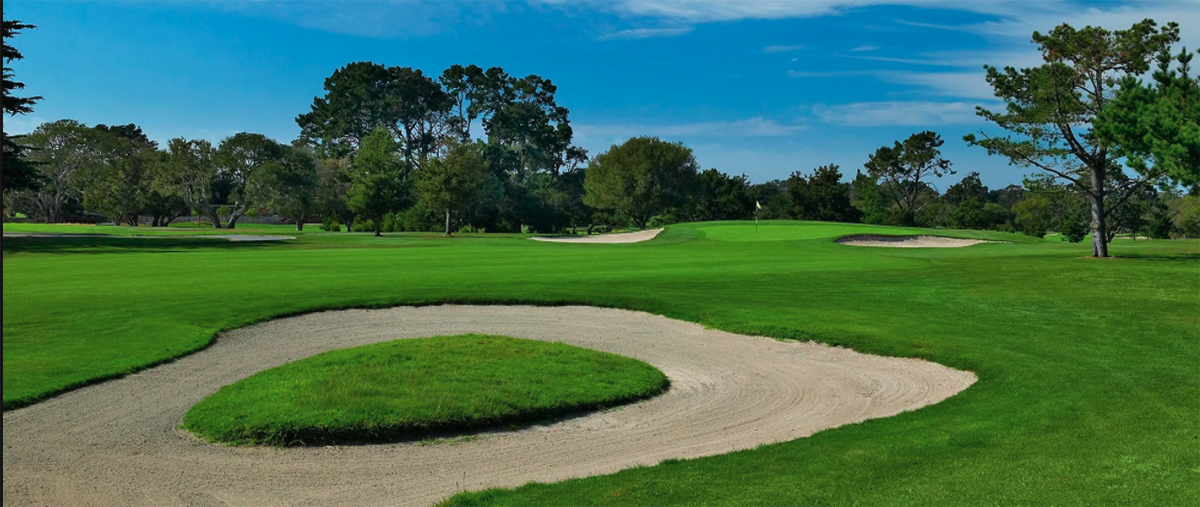
(Photo credit Pebble Beach Company)
The oldest course operating non-stop west of the Mississippi River, the Del Monte Golf Course was originally designed by Charles E. Maud in 1897 as nine-hole venue before expanding to 18 holes in 1902. The California State Amateur, founded in 1912, was held at the Del Monte Golf Course in addition to the Western Amateur in 1916. Measuring between 5355 and 6365 yards, this par-72 course is not long, but provides plenty of challenge in the form of small, sloping greens.
Front nine
1. Del Monte Golf Course begins with a par 5 measuring 505 yards. A common theme among the holes on this course is seen here with out-of-bounds along the left. A good drive sets up for an opening birdie opportunity.
2. The 2nd is a 328-yard, par 4 that is best played laying up with wedge distance from the green. A drastic sloping green from back-to-front must be hit with accuracy for best chances at birdie.
3. Although only 376 yards in length, the par 4 3rd has out-of-bounds left and a very steep green which requires players to stay short in order to walk away with par or better.
4. The 4th is a 178-yard par 3 with bunkers on either side. With pin locations generally on the left and right side of the green, the solid play is to aim for the center of the green.
5. Fairway bunkers 100 yards short of the green on the 327-yard, par 4 5th is the main obstacle on this hole. Players also need to be aware of the top-tiered green, so it’s best to keep the approach short.
6. The 6th is a tricky 196-yard, par 3 featuring a narrow opening off the tee with two large bunkers. Pick the right club because hitting long risks going out-of-bounds.
7. The play off the 7th tee on this 379-yard par 4 is over a tree in the fairway but be cautious of out-of-bounds along the left side. Precision on the approach is crucial to the three-tiered green.
8. On the 384-yard 8th, this par 4 is a dogleg right. The long hitters may opt to try to cut the corner of this dogleg. Once on the green, be aware of the quickness from front-to-back.
9. The front nine closes with a par 5 measuring 524 yards. A tee shot to the left gives the best angle for the second, however, it also brings out-of-bounds into play. The safe play is to go for the middle of the fairway and layup.
Back nine
10. The tempting play is to go for the green on this par 4 measuring 293 yards. However, there is a risk with a very small landing area if the green is missed. The safest place is go with a mid to long iron and wedge approach to the green.
11. Before teeing off on the 331-yard, par 4 11th, players should take notice of the view of the Monterey Bay. Take notice of the many bunkers in the fairway, giving plenty of club selection choices from the tee.
12. The 12th is a 171-yard, par 3 that is reachable by most with a mid-iron. The green is very tricky from above the hole, so the best chance for a good score is to aim for the front of the green.
13. This par-5 of 512 yards provides an excellent chance to blast away with the driver because it is very straight. Just be careful of out-of-bounds left, but a drive in the fairway leaves a great chance for birdie.
14. The 14th is a classic long par 3 just under 220 yards. Accuracy is the key with a long iron for most to a tricky green that has given players a challenge for over 100 years.
15. This 330-yard, par 4 hole features a dogleg to the left. The green is very quick downhill from a top tier down to the front. An uphill putt is a must for the best scoring opportunity.
16. The best approach to this 421-yard, par 4 hole is to aim for the left side of the fairway from the tee. This leaves the best angle to attack the green that slopes from back-to-front.
17. The 17th is a short par 5 of 500 yards. A drive down the right side is ideal, setting up a good chance to hit the green in two. The best chance to hole putts on this green is from below the hole.
18. The home hole is a straight-forward par 4 of just under 400 yards. The main feature is a tough green that slopes drastically from right-to-left making birdies tough to come by.
Coming Soon — The Short Course
Teaming up with TGR Design and Tiger Woods, the Pebble Beach Company is excited about their new project of creating a short course. Located directly between the Golf Academy and the Pebble Beach Pro Shop on the previous site of Peter Hay Golf Course, the vision by Woods’ design for the course is playability and creativity.
The idea for the all-par-3 course is to attract new players to the game of golf. The facility will not only have the nine-hole course, but also a large practice putting green, plus food and beverage availability in the form of a bar and kitchen. In addition, the huge outdoor patio ensures amazing views for all to enjoy.
Designed to be a great experience for the entire family, the short course will be perfect for the beginner and challenging enough for accomplished players.
Not only is the golf at these four courses among the best anywhere in the country, the lodging, amenities, dining, and other activities at Pebble Beach are also top notch. Ready to pack your bags? Let’s take a look at the lodging...

